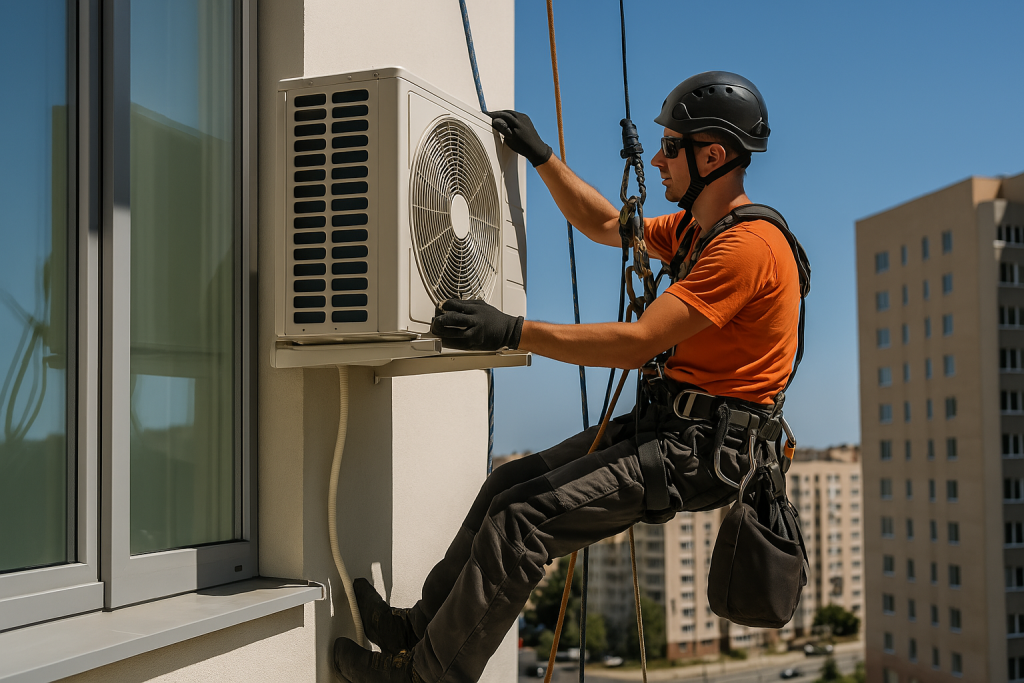Installing Air Conditioners at Height: When the Standard Approach Doesn’t Work

Installing an air conditioner is a common thing for any high-rise building or office space. However, this process is not always easy: limited access to the outer wall, a narrow yard, and the inability to install a tower or scaffolding make the standard approach inaccessible. In such situations, the solution is to involve industrial climbers who have the necessary equipment and experience in hard-to-reach areas.
Industrial mountaineering makes it possible to install an outdoor air conditioning unit even on the 16th floor, without any hassle for the residents or the management company. It is a safe, efficient and effective solution for difficult cases that does not require expensive equipment or lengthy preparatory work.
When standard installation methods don’t work
In many residential complexes, especially in the central part of the city, access to the facade from the ground is limited. The aerial platform can’t get there, and installers with ladders simply can’t reach the required point. Often, facades have architectural projections, enclosed balconies, or glass elements that complicate installation.
New buildings may have clearly defined technical zones for installing outdoor units, but in fact, they can only be accessed from the street or roof. In addition, there are situations when the old air conditioner has broken down and a new one needs to be installed in the same place, making dismantling and installation dangerous or physically impossible without special training.
When do you need an industrial climber?
Involving high-rise workers in the installation of air conditioners is not a luxury, but a necessity in many typical situations in urban environments. They allow you to avoid risking the health of residents or craftsmen, not to disturb the facade, not to spoil the landscaping of the adjacent territory.
The most common cases when a climber is indispensable:
- installation of an outdoor unit on a high floor, without a balcony;
- installation of an air conditioner on a facade with a non-standard geometry;
- work in courtyards with dense buildings or without access to equipment;
- replacement of an old unit located under a window or in a difficult place;
- installation in a technical area that is accessible only from the outside;
- installation of systems in commercial buildings, glass offices or historical sites.
Industrial climbers have certificates, permits to work at heights, and professional equipment that allows them to perform the installation with minimal interference with the building structure.
Advantages of installing air conditioners with climbers
The work of a high-altitude worker means precision, mobility and safe task performance even in difficult conditions. Unlike bulky equipment that requires logistics, permits, and blocking of the territory, a climber can arrive at the site with all the necessary equipment and start working immediately.
The advantages of this approach are obvious:
- no need to rent a tower or scaffolding;
- possibility of installation in hard-to-reach places;
- minimal inconvenience to residents or office staff;
- fast execution of works without long approvals;
- preserving the aesthetics of the facade – without drilling unnecessary holes or damage;
- safe installation, even on floors 10+.
This format of work is especially relevant for new-type residential complexes, historic buildings with facade restrictions, commercial facilities with glass walls, and when the air conditioner needs to be installed urgently, for example, in the heat of the day or before the opening of a facility.
What to consider when installing at height
When installing the outdoor unit at height, not only the access point is taken into account, but also technical nuances: the weight of the equipment, the condition of the facade, the possibility of safe connection to the power grid, condensate drainage, and the impact of weather conditions. The work is carried out in compliance with safety regulations and taking into account the architectural features of the facility. This approach allows us to integrate the equipment accurately and without unnecessary interference with the building structure, which is especially important in dense urban areas.
Interesting articles:
Installing Signs and Banners at Height: Why You Should Contact Industrial Climbers
Industrial Mountaineering in the Summer Season: What Services Are Relevant
